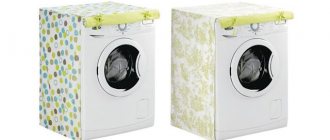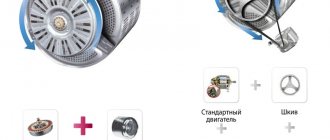Have you bought an expensive washing machine with many features and innovations, but it does not live up to your expectations? Do you use only high-quality detergents, but the results are not satisfactory? Well, it happens. Surely you once again thought that advertising is lying. But don’t rush to accuse manufacturers of washing equipment and household chemicals of dishonesty: maybe you yourself are doing something wrong? For example, you do not comply with the requirements regarding loading laundry. Correct loading of the washing machine in itself is not a guarantee of high-quality washing, but it is an indispensable condition. What does proper loading mean? From the article, readers will learn absolutely EVERYTHING about how to properly load a washing machine to achieve maximum effect.
Loading the washing machine: sorting laundry by fabric type
Are you familiar with the situation when you, without looking, rake up all the things that have accumulated in the dirty laundry basket, and also, without looking, stuff this pile into the drum of the washing machine? Never do that again!
Washing machine programmers always indicate the types of fabrics: cotton, synthetics, wool. Manufacturers do this for a reason: each type of textile has its own washing algorithms. They differ from each other in many parameters: water temperature, its quantity, drum rotation speed during washing and spinning, and the number of rinses. In addition, machines may provide special ways of operating the drum, for example, alternating rotations and stops, rocking, etc.
Competent, highly paid experts who carefully calculated each indicator worked on the development of each algorithm. By the way, their work is paid for out of your pocket, so you should not neglect their efforts and your own hard-earned money.
It is especially important to separate delicate items from the total mass: lace underwear, silk blouses, wool and cashmere items. These items of clothing require special care: loading them into the drum along with jeans or linen sheets is guaranteed to render them unusable.
However, there are always exceptions to any rule. Some modern washing machines are equipped with a special mix mode, which allows you to simultaneously wash items made from different fabrics. Washing occurs at low temperatures and not too intense spinning. There is no need to expect that whites will become snow-white, and heavily soiled ones will become very clean: similar modes are used for quick, but not too deep washing of lightly and moderately soiled mixed fabrics. Yes, lace and cashmere, after all, it is better not to mix with anything else: these things require delicate handling and their own washing regime.
Which laundry detergent to choose
Laundry detergents are available in the form of powders, gels and capsules.
Powders remove stains well. But it will take a lot of water to rinse the powder completely. Sportswear and membrane clothing cannot be washed with powder - it can clog the pores and the fabric will lose its properties.
Laundry capsules They can be used instead of three products - stain remover, fabric softener and powder. They usually cost more than other means. Plus, you won’t be able to reduce the amount of product if you are washing not very dirty clothes or if you haven’t filled the machine completely.
Liquid gels are easy to rinse out of laundry. They are universal - they can be used for washing membrane clothes and even children's underwear, if the child does not have allergies.
It is important to measure the products correctly and put in exactly as much as is written in the instructions. If you use too little gel or powder, the laundry may not wash. If you put too much, you will need more water to rinse. To add the required amount of product, use a measuring cup.
Bleach is recommended for additional disinfection of towels, bed linen and panties.
Fabric softener can be used if desired. It softens the laundry, removes static electricity and gives the laundry a pleasant aroma. But you cannot wash sports uniforms with it - the membrane fabric may lose its properties.
Loading the washing machine: white and color
Experienced housewives will never wash white and colored linen together. For a colored person, perhaps, nothing will happen, but white, perhaps, will acquire some other shade. It is better to wash pure white items separately from everything else. Even a soft blue or light pink towel, washed together with a white one, can give the latter a piece of its color.
There is no point in mixing white and colored laundry because each variety has its own type of washing powder. Detergents for white clothes often contain bleaches, which “eat away” the dyes on things of other colors. Powders and gels for colored laundry often contain substances that, on the contrary, make the colors of the items brighter, and if there are stains on your white blouse, they can also add richness.
When is ironing required?
Ironing large items is extremely tiring. There are SMAs that provide easy ironing and anti-crease functions. After the automated processes carried out by CMA, ironing duvet covers manually seems like an unaffordable waste of time. Everyone decides for themselves whether to iron or not. We will just name the situations in which it is better to go over the bedding with a hot iron:
- If someone in the household is sick. Ironing is necessary to prevent the infection from being transmitted through the bed. It is recommended to provide the patient with separate supplies.
- Kits used for children up to one year old.
- With high humidity, in which things cannot dry completely.
Loading the washing machine: weight of laundry
It would seem that it could be simpler than following the manufacturer’s recommendations regarding the weight of the laundry loaded into the drum. Usually this number is written in large print on the front panel of the washing machine. But tell me, just be honest, have you ever weighed the things you put in the wash? We believe that few readers will answer affirmatively. As a result, the machine is often overloaded.
What does this mean? Firstly, increased vibration during spins at high speed, which leads to rapid wear of the entire unit. Secondly, it leads to overheating of the motor, which has to work with increased load. And where it gets too hot, it can burn. Thirdly, in an overfilled drum, laundry will not be washed and rinsed as it should, and the quality of the wash may be unsatisfactory.
In addition, not all users know that the maximum permissible weight is not indicated for all washing programs, but only for some. In most washing machines, a full load is recommended only when synthetics, mixed and delicate fabrics are washed at half load. If we talk about things made of natural wool, lace or silk, which are marked “hand wash only”, then they are usually loaded into the machine in an amount of no more than one third of the total “carrying capacity”. Of course, if you fully load the drum with synthetics, the machine most likely will not break down. But the quality of the wash may turn out to be noticeably worse than expected.
Half load is also assumed for most so-called express programs (wash in 45, 30, 15 minutes). The machine is simply not able to wash a full drum of laundry with the same quality in an hour and a half and in a time three to six times less.
In technical documentation, manufacturers usually indicate the permissible drum load for various programs and different types of fabric. But who reads them, these instructions? After all, everything is clear to us! And, by the way, in vain!
Dry or wet?
Some users have a question: does the weight indicated on the machine refer to dry laundry or wet laundry? Washing machine repair technicians sometimes claim that it is wet. Like, the car broke down? So it’s your own fault: you overloaded!
But let's think logically: who and how will weigh a wet duvet cover or down jacket? And how do you determine if it's wet enough to count, or if you should let it get more wet? And although manufacturers do not write this directly in the documentation, the weight indicated in it refers specifically to dry laundry.
Too little is also bad
If the maximum load of the washing machine is designed for 6 - 7 kilograms, it will be a mistake not only to overload, but also to underload the washing unit. Why?
Firstly, it is uneconomical: the machine will still waste electricity, water and time. In representatives of new generations with an auto-weighing function, these indicators will be adjusted to some extent, but there will still be overspending.
Secondly, if there is underload during the spin process, the vibrations will be too strong, which is not good for the unit.
Thirdly, many machines “get lost” when the weight of the laundry is too small, and their spinning starts to malfunction. Don't be surprised when you load two shirts into a full-size machine if they come out completely wet. And don’t rush to call a repairman: the car is not broken, but simply “confused.”
Experts recommend loading at least 1 - 1.5 kg of laundry into the drum.
Loading a washing machine: what and how much does it weigh?
But let’s return to how to determine the weight of the laundry before loading it into the drum if you don’t have scales at hand. Some manufacturers in the instructions for their products provide approximate weights of various items of linen and clothing. For those who consider reading the instructions unnecessary, we will also provide this data. So
- Tablecloth 500 – 600 g
- Bed sheet 400 – 500 g
- Duvet cover 600 – 900 g
- Pillowcase 150 – 200 g
- Towel 200 – 600 g
- Pair of socks 50 g
- Underwear 50 – 250 g
- Adult blouse or shirt 100 – 250 g
- Children's blouse or shirt 80 – 150 g
- T-shirt or adult T-shirt 120 – 250 g
- T-shirt or children's T-shirt 50 - 150 g
- Dress 150 – 400 g
- Adult jeans 400 – 900 g
- Children's jeans 300 – 700 g
- Adult trousers 300 – 700 g
- Children's trousers 150 – 300 g
- Adult tracksuit 700 – 1400 g
- Children's tracksuit 400 – 700 g
- Men's business suit 1200 – 1900 g
- Women's business suit 800 – 1200 g
- Adult sweater 300 – 600 g
- Children's sweater 150 – 400 g
- Lightweight adult jacket 400 – 1200 g
- Light children's jacket 300 – 500 g
- Down jacket for adults 900 – 1800 g
- Children's down jacket 500 – 900 g
- Women's dressing gown 400 – 600 g
- Men's robe 500 – 700 g
- Children's robe 150 – 400 g
- Children's pajamas 100 – 200 g
- Baby vests, rompers 30 – 80 g
The data given above is only an estimate. The weight of different items will depend on the size and type of fabric. But no one demands that the weight of things loaded into the drum meet the standards of up to a gram. In order to navigate and ensure normal loading of the washing machine, this information is enough.
Important nuances
What else should you pay attention to when choosing? It is better to choose a large loading hatch to make it easier to get out after washing and during the loading process to distribute the weight of the laundry over the entire area of the drum. You can ignore the number of revolutions; the maximum speed develops only in spin mode. Other nuances are much more important:
- repair and warranty service - here it is not worth saving and paying for service for 5-6 years at once, rather than buying other equipment after a similar time;
- purchasing spare parts in the event of a breakdown is a pressing problem, so you need to choose a model so that there are plenty of spare parts in the region;
- effective energy saving is class A++, A+, A and B, which will help save water and electricity.
Take your time when buying household appliances: they should last you more than one year and not cause any inconvenience in use.
Washing machine loading: large and small
If you need to wash a bulky item - a blanket or, say, a down jacket, we recommend adding several smaller items to the drum. The fact is that the uniform distribution of laundry in the drum ensures high-quality washing, good spinning and quiet operation. Is it really possible to ensure uniform distribution if one down jacket, bunched up in a large and heavy lump, is spinning in the drum?
In machines equipped with an auto-balancing function, the drum will wobble or spin slightly in different directions before spinning to distribute the items in the drum. If this does not happen, the spin cycle will either be canceled altogether or will be performed at low speeds. This, on the one hand, will protect the car from damage, but on the other hand, it will leave you alone with a heavy and very wet thing.
Correct loading of the washing machine also requires a reasonable ratio of drum and laundry volumes. You should not try to cram in more things, even if their weight seems to fit the standards: things in the drum should be placed freely, and they should be placed there without effort. It is also important that the hatch door closes freely. Otherwise, the wash may be of poor quality, and tightly packed laundry will be damaged.
Dimensions
The size of the washing machine is another factor that is important to consider when purchasing. When choosing, be guided by the dimensions of the room in which the device will be installed, as well as the size of the kitchen niche if you purchase a built-in model.
Based on their dimensions, front-facing washing machines can be divided into 4 groups. The most popular and best-selling are full-size models. Their height is 85-90 cm, width and depth - 60 cm. Narrow washing machines with a similar height and width have a depth of only 35-40 cm, and ultra-narrow ones - 32-35 cm. Compact models, designed for installation under the sink, have a height of only 68-70 cm, width 47-50 cm, and their depth is 43-45 cm.
As we already mentioned at the beginning of the article, the dimensions of top-loading washing machines are practically the same from different manufacturers: height 85-90 cm, depth 60-65 cm, width 40-45 cm.
Loading the washing machine: delicates
We mentioned above that there are special modes for delicate items. But this does not mean that the user is only required to turn the program switch knob to the correct position. Lace items and other items marked “hand wash only,” as well as thin tights and stockings, must be placed in a special mesh bag before loading into the drum. We advise you to do the same with things that are old but valuable to you.
Separately, it is worth mentioning bras with underwires. If you want to wash them in the washing machine, it is better to load them into the drum separately from other laundry and avoid spinning them. It is not difficult to wring out a small bra with your hands, and you will be sure that the escaped bone will not turn the rest of your underwear into rags during the rapid rotation of the drum.
Installation
To be sure of the correct operation of the unit, it is better to entrust the installation of equipment to specialists. If your own professionalism is not in doubt, you can try to do it yourself.
The main point that is worth considering during installation is that the washing machine should under no circumstances vibrate strongly or “jump” during the spin cycle. What does that require? First of all, choose a suitable place. When the bathroom floor is uneven, the flaws can be easily corrected by purchasing a special rubber mat for the machine. After that:
- Remove the shipping anchors supporting the drum. This manipulation is very easy, just take a wrench and unscrew the bolts on the back cover of the equipment.
- Adjust the legs of the equipment . Often they are screwed into the unit using the principle of bolts. To position the legs correctly, you need to place a level on the machine, thus controlling the degree of their height.
If the machine begins to “jump” some time after installation, it may have developed problems. In this case, you should immediately contact a specialist.
Article on the topic: 6 most common washing machine malfunctions and how to fix them
Loading the washing machine: other important rules.
Many users forget to check their pockets when loading things into the car. As a result, coins, checks, small bills and other small items end up in the water. This risks causing your drain filter to become clogged soon. And consider yourself lucky if the little things forgotten in your pockets are not coloring. But if you forget a cosmetic pencil in your jacket pocket, the washing result can be very shocking.
To protect the filter from clogging, before washing it is worth turning duvet covers and pillowcases inside out, removing feathers and lint. This will also improve the quality of washing: lint and feathers will not stick to things in the drum.
It is important to fasten all buttons and zippers. An unzipped zipper can tear to shreds everything that gets in the way.
If you tried to remove the stain with gasoline or some kind of solvent, and then want to wash the clothes, do not rush to put such an item in the machine: it is better to wait until the substance has completely evaporated from the fabric. To do this, it is better to hang the item in the fresh air for an hour.
Here, in fact, is everything you need to know on the topic “Proper loading of the washing machine.” If the material was not exhaustive, please add it in the comments, and to consolidate what you have covered, we suggest watching a short video.
How often should I wash?
The frequency of washing in each home is different. It is influenced by the intensity of use, the presence of children and pets in the house, personal preferences and views on cleanliness. Here are some useful tips:
- Throw your sheets and pillowcases in the wash at the first sign of loss of freshness. It is recommended to do this weekly. Duvet covers get dirty less, so you can run a gentle 30-degree program for them.
- If the frequency of water procedures is less than once a week, set the regime for a specific type of fabric and take into account the degree of contamination.
- You shouldn’t store a dirty set in a basket for a long time - while it lies there crumpled, dirt will eat into it intensely. It will be more difficult to wash such a set, and also to iron it.
What happens if you overfill the washing machine?
The laundry will “clump” in one place, causing the machine to make noise and vibrate. If there is an imbalance sensor, the intelligence will stop the machine from working. Another consequence of periodically overfilling the drum will be damage to the dampers.
Interesting materials:
How to delete a payment card on Instagram? How to delete categories in Gmail? How to delete cache from telegram? How to delete the cache of deleted Android applications? How to remove acid from batteries? How to remove adhesive from fabric? How to remove Bustilat glue from the floor? How to remove Bustilat glue from the wall? How to remove carpet adhesive? How to remove linoleum glue from the floor?
Some more useful tips
- Use special laundry bags - place pillowcases, sheets, and duvet covers there.
- To make things less wrinkled, reduce the spin speed. If the maximum for a particular type of fabric is 1000 rpm, set it to 800.
- Add conditioner. Thanks to it, the sheets acquire a pleasant smell and softness, and the formation of wrinkles is prevented.
- Use starch impregnation - it makes smoothing easier and prevents contamination. Regularly starched items last longer.
- Newly purchased sets must be washed and ironed.











